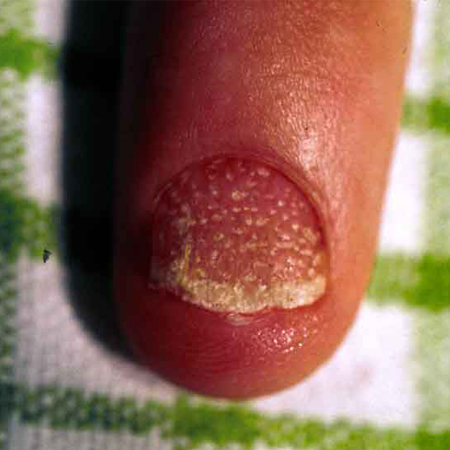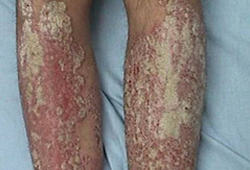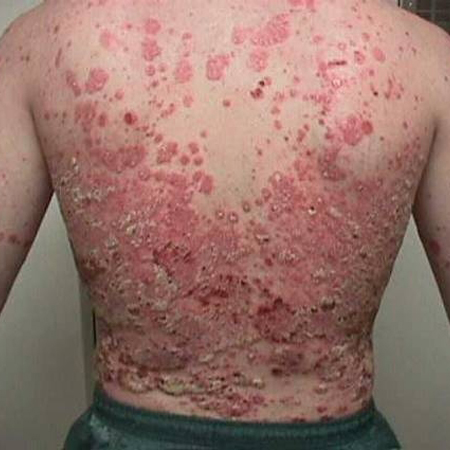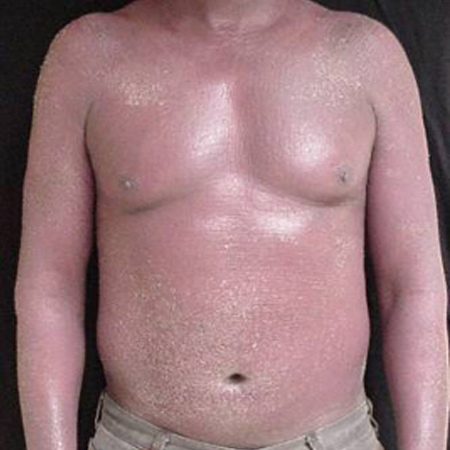History and exam
Key diagnostic factors
common
skin lesions
Typically erythematous, circumscribed scaly papules and plaques on elbows, knees, extensor surfaces of limbs, scalp, and, less commonly, nails, ears, and umbilical region.[Figure caption and citation for the preceding image starts]: Nail psoriasis - pitted nailsFrom the collection of Professor Tsu-Yi Chuang, MD, MPH, FAAD; used with permission [Citation ends].
In plaque psoriasis, there are raised inflamed plaque lesions with a superficial silvery-white scaly eruption. The scale may be scraped away to reveal inflamed and sometimes friable skin beneath.[2] Pinpoint bleeding points are known as Auspitz's sign.[Figure caption and citation for the preceding image starts]: Plaque psoriasis on legsFrom the collection of Professor Tsu-Yi Chuang, MD, MPH, FAAD; used with permission [Citation ends]. [Figure caption and citation for the preceding image starts]: Plaque psoriasis on backFrom the collection of Professor Tsu-Yi Chuang, MD, MPH, FAAD; used with permission [Citation ends].
[Figure caption and citation for the preceding image starts]: Plaque psoriasis on backFrom the collection of Professor Tsu-Yi Chuang, MD, MPH, FAAD; used with permission [Citation ends]. [Figure caption and citation for the preceding image starts]: Plaque psoriasis on kneeFrom the collection of Professor Tsu-Yi Chuang, MD, MPH, FAAD; used with permission [Citation ends].
[Figure caption and citation for the preceding image starts]: Plaque psoriasis on kneeFrom the collection of Professor Tsu-Yi Chuang, MD, MPH, FAAD; used with permission [Citation ends]. [Figure caption and citation for the preceding image starts]: Plaque psoriasis on footFrom the collection of Professor Tsu-Yi Chuang, MD, MPH, FAAD; used with permission [Citation ends].
[Figure caption and citation for the preceding image starts]: Plaque psoriasis on footFrom the collection of Professor Tsu-Yi Chuang, MD, MPH, FAAD; used with permission [Citation ends]. [Figure caption and citation for the preceding image starts]: Plaque psoriasis on scalpFrom the collection of Professor Tsu-Yi Chuang, MD, MPH, FAAD; used with permission [Citation ends].
[Figure caption and citation for the preceding image starts]: Plaque psoriasis on scalpFrom the collection of Professor Tsu-Yi Chuang, MD, MPH, FAAD; used with permission [Citation ends].
In guttate psoriasis, there are widespread, erythematous, fine, scaly papules (water drop appearance) on trunk, arms, and legs. The lesions often erupt after an upper respiratory infection.[2][Figure caption and citation for the preceding image starts]: Guttate psoriasisFrom the collection of Professor Tsu-Yi Chuang, MD, MPH, FAAD; used with permission [Citation ends].
In pustular psoriasis, acute generalised pustular psoriasis (von Zumbusch) is rare, severe, and urgent; palmoplantar pustulosis affects palms and soles and is chronic.[2][Figure caption and citation for the preceding image starts]: Pustular psoriasisFrom the collection of Professor Tsu-Yi Chuang, MD, MPH, FAAD; used with permission [Citation ends].
In erythroderma (erythrodermic psoriasis), there is generalised erythema with fine scaling. It is often associated with pain, irritation, and sometimes severe itching.[2][Figure caption and citation for the preceding image starts]: ErythrodermaFrom the collection of Professor Tsu-Yi Chuang, MD, MPH, FAAD; used with permission [Citation ends].
Other diagnostic factors
common
family history
joint swelling or pain
Psoriatic arthritis occurs in 20% of people with psoriasis and can point towards a diagnosis of cutaneous psoriasis.[3]
Psoriatic arthritis has several presentations including joint pain, tendinitis, enthesitis, or dactylitis. In most cases arthritis presents after the onset of cutaneous psoriasis, but it may be a presenting sign.[49]
Risk factors for psoriatic arthritis include early age at first presentation, female sex, polyarticular involvement, and genetic predisposition.[50]
Risk factors
strong
genetic
Most people with psoriasis have a positive family history.[11][16]
Studies of monozygotic twins, linkage studies, and genome-wide association studies provide evidence that psoriasis has a genetic predisposition.[11][12][13]
Psoriasis has been linked to a number of genes, with the strongest association to those involved in the immune response, particularly IL23R, IL12B, and tumour necrosis factor (TNF)-alpha.[14]
infection
local trauma
Trauma, such as surgical scars and injection sites, may result in the appearance of new psoriatic lesions at the site of injury.[29] This is known as the Koebner phenomenon.
medications
Several medications may induce or exacerbate pre-existing psoriasis (the incidence of psoriasis exacerbation is generally greater than that of psoriasis induction), including antihypertensives and lithium.[30]
The latency period between drug ingestion and psoriasis flares varies, and can be considerable for certain medications.[31][32]
weak
stress
smoking
alcohol
greater body mass index (BMI)
Use of this content is subject to our disclaimer